|
3891| 0
|
[用户分享] 【TinkerNode NB-IoT 物联网开发板】测评(二)运行出厂默认... |
|
【TinkerNode NB-IoT 物联网开发板】测评(二)运行出厂默认程序 【TinkerNode NB-IoT 物联网开发板】测评(一)开箱验机 【TinkerNode NB-IoT 物联网开发板】测评(二)运行出厂默认程序 【TinkerNode NB-IoT 物联网开发板】测评(三)MQTT控制板载LED灯开关 【TinkerNode NB-IoT 物联网开发板】测评(四)移动应用开发 出厂默认程序真是个好东西,里面有七大功能,涵盖了TinkerNoder的主要功能。运行默认程序能够很快上手并了解设备,进而做进一步开发。 [mw_shl_code=cpp,false]/*! * @file Default_run.ino * @brief This code is TinkerNode NB-IoT Dev Board(CH) quick start demo * * @n Short press SET to switch different modes. * @n Long press SET for over 1 sec to turn on/off a specific mode. * @n Mode cycle: 1->2->3->4->5->6->7->1... * @n 1. Default mode. (rainbow); * @n 2. NB-IoT signal detection mode. (White) * @n 3. NB-IoT AT command mode. (Purple) * @n 4. WiFi scan mode. (Yellow) * @n 5. WiFi connection mode. (Green) * @n 6. Bluetooth mode. (Blue) * @n 7. GNSS mode. (Cyan) * * @n AT commands can be sent to the BC20 module via USB Serial.(NB-IoT AT command mode) * @n Commonly used AT commands: * @n AT - AT command test * @n AT+QRST=1 - Reset BC20 * @n ATI - Revision of the firmware release * @n AT+CSQ - Signal quality report * @n 0 - <=-113 dBm * @n 1 - -111 dBm * @n 2 - -109 dBm * @n 3 - -107 dBm * @n ... * @n 30 - -53 dBm * @n 31 - >-51 dBm * @n 99 - Not known or not detectable * @n AT+CGATT? - PS attach or detach. Query network connection state. * @n 0 - Disconnected from the network * @n 1 - Connected to the network * @n AT+CGATT=1 - Connect to the network * @n AT+CGATT=0 - Disconnected from the network * @n AT+CIMI - Query the IMSI number of BC20 * @n AT+CGSN=1 - Query the IMEI of the BC20. * @n AT+CGSN=0 - Query the SN(Serial Number) of the BC20. * @n AT+QCCID - USIM Card Identification(ICCID). This is usually used to check SIM card state. * @n AT+CCLK? - Return current date and time * @n AT+QPOWD=0 - Power off the module.(use "myBC20.powerOn()" to power on the module) * * @n The following AT commands are for GNSS: * @n AT+QGNSSC? - Query GNSS power state * @n 0 - GNSS power off * @n 1 - GNSS power on * @n AT+QGNSSC=1 - power on GNSS * @n AT+QGNSSC=0 - power off GNSS * @n AT+QGNSSRD? - Obtain all GNSS info * * @n For more details please refer to the "Quectel BC20 AT Commands Manual" * @n or the "BC20 GNSS AT Commands Manual" * * @Copyright Copyright (c) 2010 DFRobot Co.Ltd (http://www.dfrobot.com) * @licence The MIT License (MIT) * @author Wuxiao(xiao.wu@dfrobot.com) * @version V1.0 * @date 2019-10-29 * @get from https://www.dfrobot.com */ #include <DFRobot_NeoPixel.h> #include <WiFi.h> #include <DFRobot_BC20.h> #include "DFRobot_LED.h" #include "DFRobot_BLESerial.h" #include "time.h" /*Functions definition*/ //Buttom SET connected to ESP32 pin13 pulled up with a 10K Ohm resistor #define ButtonPin 13 #define Default 0 #define NB_SIGNAL 1 #define NB_SERIAL 2 #define WIFI_SCAN 3 #define WIFI_CONNECT 4 #define BLE 5 #define GNSS 6 DFRobot_BC20 myBC20; DFRobot_LED LED; DFRobot_BLESerial SerialBLE; static uint8_t SysMode = 0; bool ModeStatus = false; static bool WaitingStart(uint8_t status) { //Serial.println("standing by..."); while (!ModeStatus) { if (SysMode == status) { RGB_LED.Breathing(); } else { return false; } } return true; } static void Default_Fun() { //Introduction: start the default mode, standby state //Flash 5 times in white. No error, rainbow change, standby state. There are errors, red indicates various errors. Serial.println("Default mode. Standing by..."); RGB_LED.clear(); RGB_LED.setColor(WHITE); for (int i = 0; i < 5; i++) { RGB_LED.FastFlash(); } while (1) { if (SysMode == Default) { RGB_LED.rainbow(5); } else { break; } } } static void NB_Signal_Fun() { /* * Introduction: * Turn on the BC20 and automatically connect to the network, * print the signal strength through the serial port, * and indicate the signal strength (high, medium, low) by the blinking frequency of the RGB or L indicator. * RGB: * Off - breathing light. * When NB is connected, the signal strength is indicated by the frequency of the flashing light, * which divided into three steps: * Strong signal - fast flash * Medium signal - slow flash * Weak signal - burst flash. */ Serial.println("NB-IoT signal detection mode."); Serial.println("Long press SET for over 1 sec to start..."); RGB_LED.clear(); RGB_LED.setColor(WHITE); if (!WaitingStart(NB_SIGNAL)) return; // Power on NB-IoT module BC20 Serial.print("Starting the BC20. Please wait... "); while (!myBC20.powerOn()) { RGB_LED.BurstFlash(); Serial.print("."); } Serial.println("BC20 started successfully !"); //Check whether a NB-IoT SIM card is available. while (!myBC20.checkNBCard()) { Serial.println("Please insert the NB SIM card !"); delay(1000); } myBC20.getGSN(IMEI); Serial.print("BC20 IMEI: "); Serial.println(sGSN.imei); Serial.print("SIM card ICCID:"); Serial.println(myBC20.getQCCID()); Serial.print("SIM card IMSI: "); Serial.println((char *)myBC20.getIMI()); Serial.println("Connecting network "); //Check whether it is attached to the network //BC20 will automatically connect and register on network after power on while (myBC20.getGATT() == 0) { Serial.print("."); delay(1000); } Serial.println("Network connected!"); while (1) { /* * The RGB indicator is ONLY available when powered by USB or VIN(6-24V external) * Uncomment the "led" related sentences and comment the "RGB" to use L(blue) indicator * The blue LED can be used when RGB indicator is not available (i.e. powered by battery or solar) */ if (SysMode == NB_SIGNAL && ModeStatus == true) { myBC20.getSQ(); //Signal quality RSSI<10, weak signal strength if (sSQ.rssi < 10 || sSQ.rssi == 99) { RGB_LED.BurstFlash(); //led.BurstFlash(); if (sSQ.rssi == 99) { Serial.println("Signal not detectable"); } else if (sSQ.rssi == 0) { Serial.println("Signal Strength: -113 dBm or less"); } else { Serial.print("Signal Strength: "); Serial.print((sSQ.rssi - 2) * 2 - 109); Serial.println(" dBm Weak"); } } //Signal quality 10<=RSSI<25, medium signal strength else if (sSQ.rssi >= 10 && sSQ.rssi < 25) { RGB_LED.SlowFlash(); //led.SlowFlash(); Serial.print("Signal Strength: "); Serial.print((sSQ.rssi - 2) * 2 - 109); Serial.println(" dBm Medium"); } //Signal quality RSSI>=25, strong signal strength else if (sSQ.rssi >= 25) { if (sSQ.rssi < 31) { for (int i = 0; i < 5 ; i++) { RGB_LED.FastFlash(); //led.FastFlash(); } Serial.print("Signal Strength: "); Serial.print((sSQ.rssi - 2) * 2 - 109); Serial.println(" dBm Strong"); } else if (sSQ.rssi == 31) { Serial.print("Signal Strength: -51 dBm or greater"); } } } else { break; } } } static void NB_Serial_Fun() { /* * Introduction: * Open BC20 and transparently transmit the serial data of PC (host computer) to BC20 * RGB: * Off - breathing light * NB module starting - slow flash * Start complete - constantly Bright */ Serial.println("NB-IoT AT command mode."); Serial.println("Long press SET for over 1 sec to start..."); RGB_LED.clear(); RGB_LED.setColor(PURPLE); if (!WaitingStart(NB_SERIAL)) return; Serial.print("Starting the BC20. Powering on"); while (!myBC20.powerOn()) { if (SysMode == NB_SERIAL && ModeStatus == true) { RGB_LED.SlowFlash(); Serial.print("."); } else { break; } } RGB_LED.ConstantlyBright(); myBC20.ConfigSleepMode(eSleepMode_Disable); Serial.println(); Serial.println("Configure the serial monitor as \"Carriage return\" before sending the AT commands"); Serial.println("For AT commands, please refer to \"Quectel BC20 AT commands Manual\""); Serial.println("Send AT commands to configure:"); while (1) { if (SysMode == NB_SERIAL && ModeStatus == true) { if (Serial.available()) { BC20Serial.write((char)Serial.read()); } if (BC20Serial.available()) { Serial.write((char)BC20Serial.read()); } } else { break; } } } static void WiFiScan() { //Wifi scan function WIFI_Scan_Fun () subroutine Serial.println("Scan starts."); // WiFi.scanNetworks will return the number of networks found int n = WiFi.scanNetworks(); Serial.println("scan done"); if (n == 0) { Serial.println("no networks found"); } else { Serial.print(n); Serial.println(" networks found"); for (int i = 0; i < n; ++i) { // Print SSID and RSSI for each network found Serial.print(i + 1); Serial.print(": "); Serial.print(WiFi.SSID(i)); Serial.print(" ("); Serial.print(WiFi.RSSI(i)); Serial.print(" dBm )"); Serial.println((WiFi.encryptionType(i) == WIFI_AUTH_OPEN) ? " " : "*"); delay(10); } } Serial.println(""); } static void WIFI_Scan_Fun() { /* * Introduction: * Scan the current wifi signal and print the wifi name and model strength through the serial port * RGB: * Off - breathing light * WiFi scan starting - constantly Bright * Scanned wifi - fast flash 5 times */ Serial.println("WiFi scan mode."); Serial.println("Long press SET for over 1 sec to start..."); RGB_LED.clear(); RGB_LED.setColor(YELLOW); if (!WaitingStart(WIFI_SCAN)) return; RGB_LED.ConstantlyBright(); WiFi.mode(WIFI_STA); WiFi.disconnect(); delay(100); while (1) { if (SysMode == WIFI_SCAN && ModeStatus == true) { WiFiScan(); for (int i = 0; i < 5 ; i++) { RGB_LED.FastFlash(); } } else { break; } } } const char* ntpServer = "pool.ntp.org"; const long gmtOffset_sec = 8 * 3600; const int daylightOffset_sec = 0; void printLocalTime(){ struct tm timeinfo; if (!getLocalTime(&timeinfo)) { Serial.println("Failed to obtain time"); return; } AnalysisTime(&timeinfo); //Print the current time format as "YYYY/MM/DD, week, hh:mm:ss" Serial.printf("%04d/%02d/%02d,", timeinfo.tm_year, timeinfo.tm_mon, timeinfo.tm_mday); Serial.print(&timeinfo, "%A,"); Serial.printf("%02d:%02d:%02d GMT+8\r\n", timeinfo.tm_hour, timeinfo.tm_min, timeinfo.tm_sec); } static void WIFI_Connect_Fun() { /* Introduction: * User is required to enter the WiFi SSID and password to be connected. * If it is unable to connect within 10s(timeout), It will require to enter the correct SSID and password again. * After the WiFi is connected, current date and time will be calibrated through the Internet and printed * every 1s. * RGB: * Off - breathing light. * Enter SSID and password - slow flash . * Connecting WiFi device - fast flash. * Connected WiFi - constantly Bright. */ char str_temp; uint8_t timeout_cnt = 0; uint32_t timeStamp; Serial.println("WiFi connection mode."); Serial.println("Long press SET for over 1 sec to start..."); RGB_LED.clear(); RGB_LED.setColor(GREEN); if (!WaitingStart(WIFI_CONNECT)) return; String WiFi_SSID = ""; String WiFi_Password = ""; while (WiFi.status() != WL_CONNECTED) { if (SysMode != WIFI_CONNECT || ModeStatus == false) return; //Enter WiFi SSID and Password in serial monitor. //End with "Newline" or "Carriage return" Serial.print("Enter WiFi SSID: "); while (1) { if (Serial.available()) { str_temp = (char)Serial.read(); if ( str_temp != '\n' && str_temp != '\r') { WiFi_SSID = String(WiFi_SSID + str_temp); } else { break; } } } Serial.println(WiFi_SSID.c_str()); RGB_LED.SlowFlash(); while (Serial.available()) Serial.read(); Serial.print("Enter WiFi Password: "); while (1) { if (Serial.available()) { str_temp = (char)Serial.read(); if (str_temp != '\n' && str_temp != '\r') { WiFi_Password = String(WiFi_Password + str_temp); } else { break; } } } Serial.println(WiFi_Password.c_str()); RGB_LED.SlowFlash(); while (Serial.available()) Serial.read(); WiFi.begin(WiFi_SSID.c_str(), WiFi_Password.c_str()); WiFi_SSID = ""; WiFi_Password = ""; timeStamp = millis(); Serial.print("Connecting"); while (WiFi.status() != WL_CONNECTED) { RGB_LED.FastFlash(); Serial.print("."); if (millis() - timeStamp > 10000) { Serial.println("Connection timeout!"); break; } } } RGB_LED.ConstantlyBright(); Serial.println(); Serial.println("WiFi connected."); Serial.print("IP Adderss: "); Serial.println(WiFi.localIP()); //Init and get the time configTime(gmtOffset_sec, daylightOffset_sec, ntpServer); while (1) { if (SysMode == WIFI_CONNECT && ModeStatus == true) { //Print current time every second printLocalTime(); delay(1000); } else { WiFi.disconnect(true); WiFi.mode(WIFI_OFF); break; } } } /*BLE configuration*/ String BLE_Name = String("TinkerNode NB-IoT(0x" + String(random(0xFFFF), HEX) + ")"); uint8_t ble_first = 1; static void BLE_Fun() { /* * Introduction: * Creates a bridge between Serial and Classical Bluetooth (SPP) * RGB: * Off - breathing light. */ char strTemp; Serial.println("Bluetooth mode."); Serial.println("Long press SET for over 1 sec to start..."); RGB_LED.clear(); RGB_LED.setColor(BLUE); if (!WaitingStart(BLE)) return; if (ble_first) { SerialBLE.begin(BLE_Name.c_str()); ble_first = 0; } else { } Serial.println("The device started, now you can pair it with bluetooth!"); Serial.print("BLE device name: "); Serial.println(BLE_Name); while (1) { if (SysMode == BLE && ModeStatus == true) { if (Serial.available()) { SerialBLE.write(Serial.read()); } //Send character "0" to turn off L, "1" to turn on L and "1" to blink L if (SerialBLE.available()) { strTemp = SerialBLE.read(); if ( strTemp == '0') { led.off(); Serial.println("L is OFF."); } else if ( strTemp == '1') { led.on(); Serial.println("L is ON."); } else{ Serial.write(strTemp); } } } else { break; } } } void Display_Location_Information() { Serial.print("Time:\t\t"); Serial.print(sCLK.Year); Serial.print("/"); Serial.printf("%02d", sCLK.Month); Serial.print("/"); Serial.printf("%02d ", sCLK.Day); Serial.printf(" %02d", sCLK.Hour); Serial.printf(":%02d", sCLK.Minute); Serial.printf(":%02d\r\n", sCLK.Second); Serial.print("Latitude:\t"); Serial.print(sGGNS.LatitudeVal, 6); Serial.print(" "); Serial.println(sRMC.LatitudeDir); Serial.print("Longitude:\t"); Serial.print(sGGNS.LongitudeVal, 6); Serial.print(" "); Serial.println(sRMC.LongitudeDir); Serial.print("Altitude:\t"); Serial.print(sGGNS.Altitude, 1); Serial.println(" m"); Serial.print("Speed:\t\t"); Serial.print(sGGNS.Speed); Serial.println(" km/h"); Serial.print("Heading:\t"); Serial.print(sGGNS.Heading); Serial.println(" deg"); Serial.print("Status:\t\t"); Serial.println(sGGNS.FixStatus); Serial.print("PDOP:\t\t"); Serial.println(sGGNS.PDOP); Serial.print("HDOP:\t\t"); Serial.println(sGGNS.HDOP); Serial.print("VDOP:\t\t"); Serial.println(sGGNS.VDOP); Serial.println(); } void Display_Satellite_Information() { Serial.print(sSAT.NUM); Serial.println(" in view."); Serial.print(sSAT.USE); Serial.println(" in used."); Serial.print("PRN:\t"); Serial.print("Elev:\t"); Serial.print("Azim:\t"); Serial.print("SNR:\t"); Serial.print("SYS:\t"); Serial.println("Used:"); for (uint8_t i = 0; i < sSAT.NUM; i++) { Serial.print(sSAT.data.PRN); Serial.print("\t"); Serial.print(sSAT.data.Elev); Serial.print("\t"); Serial.print(sSAT.data.Azim); Serial.print("\t"); Serial.print(sSAT.data.SNR); Serial.print("\t"); Serial.print(sSAT.data.SYS); Serial.print("\t"); Serial.println(sSAT.data.Status); } } static void GNSS_Fun() { /* * Introduction: * Open GNSS BCSS to obtain positioning related information * RGB: * Off - breathing light. * Open (search star) - fast flash. * Connected (positioning via satellite) - Constantly Bright. */ Serial.println("GNSS mode."); Serial.println("Long press SET for over 1 sec to start..."); RGB_LED.clear(); RGB_LED.setColor(CYAN); WaitingStart(GNSS); if (!WaitingStart(GNSS)) return; Serial.print("Starting the BC20.Please wait. . . "); while (!myBC20.powerOn()) { delay(1000); Serial.print("."); } Serial.println(); Serial.println("BC20 started successfully !"); Serial.println("check OK"); if (myBC20.getQGNSSC() == OFF) { Serial.println("GNSS is ON"); myBC20.setQGNSSC(ON); } while (1) { if (SysMode == GNSS && ModeStatus == true) { myBC20.getQGNSSRD(); //Dispaly basic info of GNSS Display_Location_Information(); //Dispaly satellite info of GNSS Display_Satellite_Information(); Serial.println(""); if (!sRMC.PositioningMode.equals("N")) { for (int i = 0; i < 5 ; i++) RGB_LED.FastFlash(); } else { RGB_LED.SlowFlash(); } } else { break; } } } void setup() { Serial.begin(115200); RGB_LED.begin(); RGB_LED.setBrightness(MIDDLE); pinMode(ButtonPin, INPUT); attachInterrupt(ButtonPin, IntFun, CHANGE); //Print info. and instructions Serial.println(); Serial.println("------------------------------------------------------------"); Serial.println("Welcome to TinkerNode NB-IoT Dev Board(CH) quick start demo."); Serial.println("------------------------------------------------------------"); Serial.println("Short press SET to switch different modes"); Serial.println("Long press SET for over 1 sec to turn on/off a specific mode"); Serial.println("Mode cycle: 1->2->3->4->5->6->7->1..."); Serial.println("1. Default mode. (rainbow)"); Serial.println("2. NB-IoT signal detection mode. (White)"); Serial.println("3. NB-IoT AT command mode. (Purple)"); Serial.println("4. WiFi scan mode. (Yellow)"); Serial.println("5. WiFi connection mode. (Green)"); Serial.println("6. Bluetooth mode. (Blue)"); Serial.println("7. GNSS mode. (Cyan)"); } void loop() { switch (SysMode) { case NB_SIGNAL: NB_Signal_Fun(); break; case NB_SERIAL: NB_Serial_Fun(); break; case WIFI_SCAN: WIFI_Scan_Fun(); break; case WIFI_CONNECT: WIFI_Connect_Fun(); break; case BLE: BLE_Fun(); break; case GNSS: GNSS_Fun(); break; default: Default_Fun(); break; } } static uint32_t nextTime = 0; void IntFun() { if (digitalRead(ButtonPin) == HIGH) { //long press: hold over 1 sec if (millis() - nextTime > 1000) { if ( ModeStatus == false) { ModeStatus = true; Serial.println("Starting..."); } else { ModeStatus = false; Serial.println("Turning off..."); } } //short press: 100 ms debounce else if (millis() - nextTime > 100) { ModeStatus = false; SysMode++; if (SysMode > 6) { SysMode = 0; } Serial.println("Switching mode..."); } } else { } nextTime = millis(); }[/mw_shl_code] 因为板子写过其他程序,所以需要重新烧录出厂默认程序。 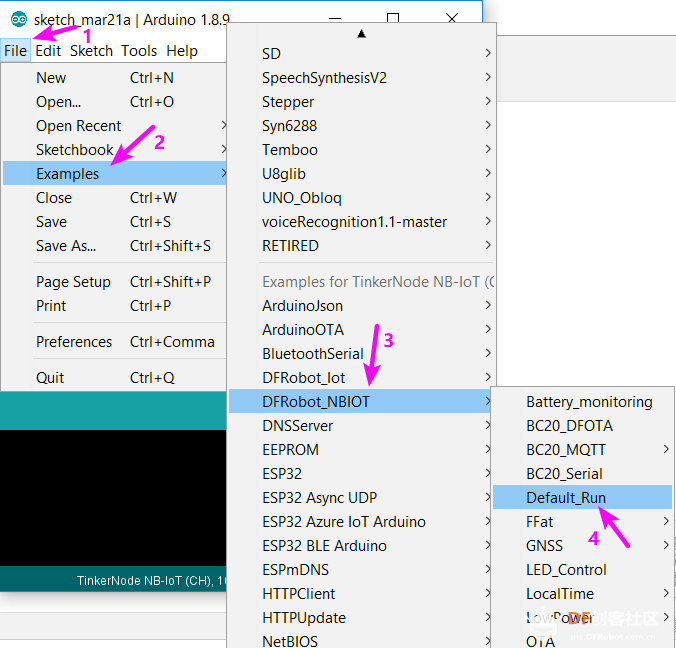 开发板在出厂前已烧录程序,便于用户体验与验证开发板的主要功能。程序包括下面7个功能,短按SET在7种功能中循环切换,长按SET打开/关闭该功能: "每次按SET切换到下一个功能,该功能都默认处于关闭状态(无论之前是否打开过),需要再长按SET才能开启该功能。" [mw_shl_code=cpp,false] * @n Short press SET to switch different modes. * @n Long press SET for over 1 sec to turn on/off a specific mode. * @n Mode cycle: 1->2->3->4->5->6->7->1... * @n 1. Default mode. (rainbow); * @n 2. NB-IoT signal detection mode. (White) * @n 3. NB-IoT AT command mode. (Purple) * @n 4. WiFi scan mode. (Yellow) * @n 5. WiFi connection mode. (Green) * @n 6. Bluetooth mode. (Blue) * @n 7. GNSS mode. (Cyan)[/mw_shl_code] 1.RGB七彩变换:上电默认运行。板载RGB灯进行七彩变换,可验证RGB灯是否正常显示。 这个模式无需长按,上电后自动运行。 2.NB-IoT信号测试:RGB指示灯白色。
我测试的时候是慢闪,1秒亮,1秒灭。 下面的动图可以看到模式的切换。 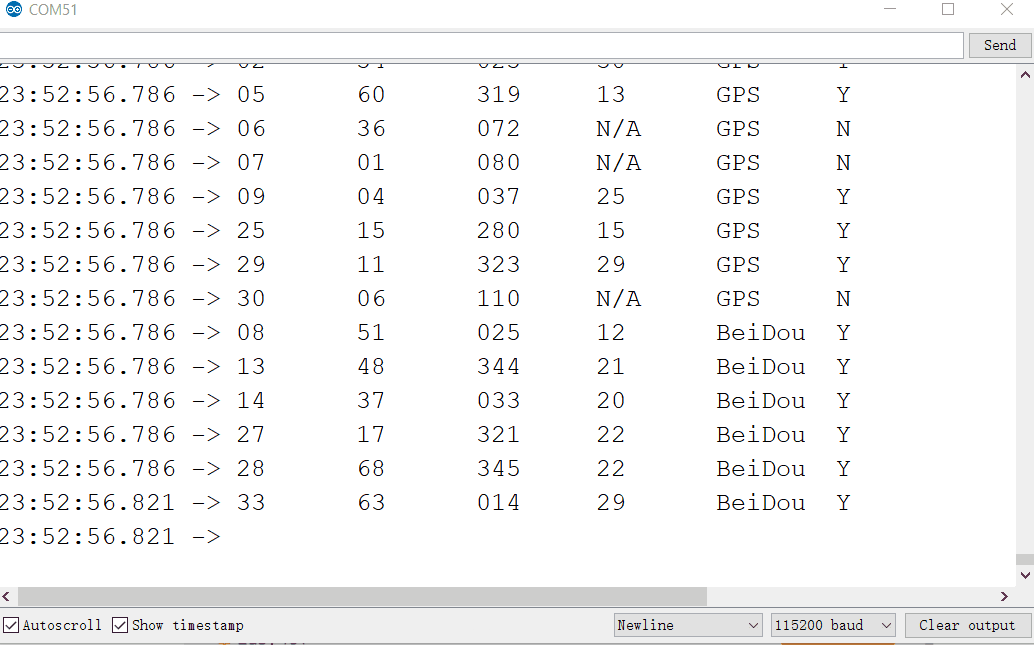 在NB IOT模式下从串口监视器可以看到IMIE、SIM卡的UUID和IMSI 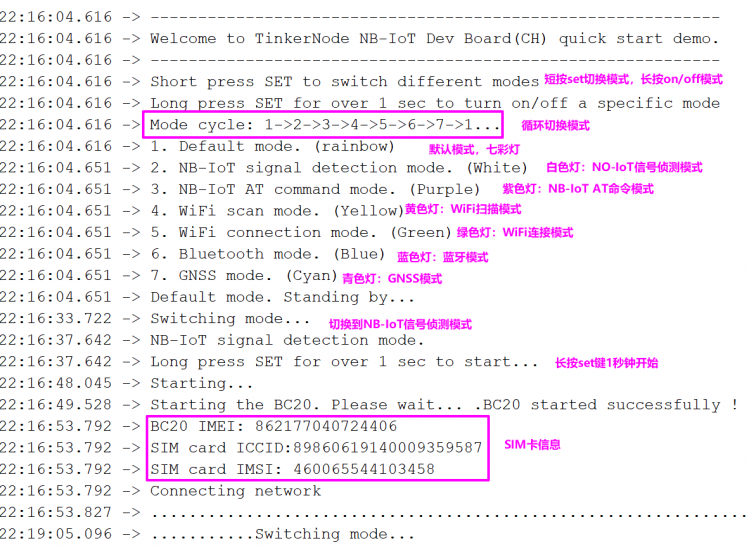 3.NB-IoT AT指令串口透传:RGB指示灯紫色。 [mw_shl_code=cpp,false] * @n AT commands can be sent to the BC20 module via USB Serial.(NB-IoT AT command mode) * @n Commonly used AT commands: * @n AT - AT command test * @n AT+QRST=1 - Reset BC20 * @n ATI - Revision of the firmware release * @n AT+CSQ - Signal quality report[/mw_shl_code] 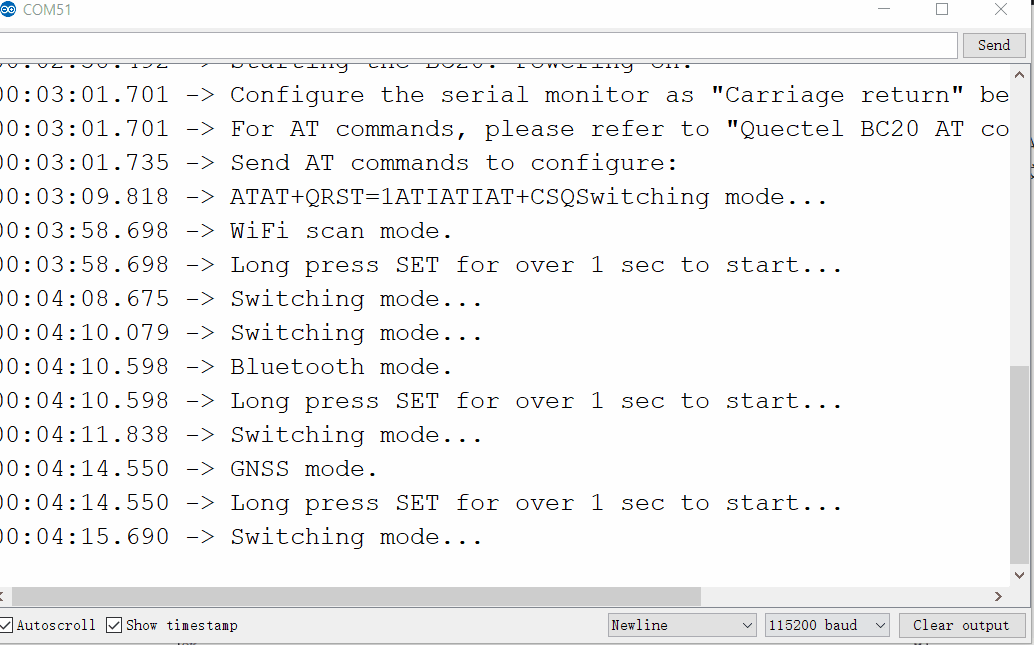 4.WiFi信号扫描:RGB指示灯黄色。 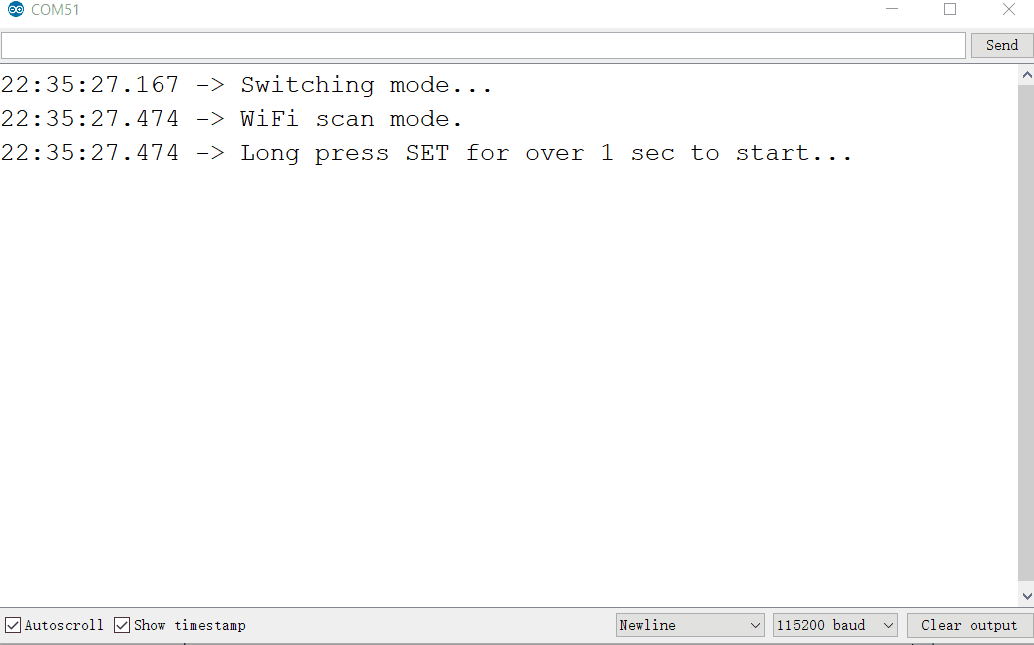 会扫描wifi信号,最后显示所有扫描到的wifi的SSID及信号强度。 5.WiFi连接:RGB指示灯绿色。 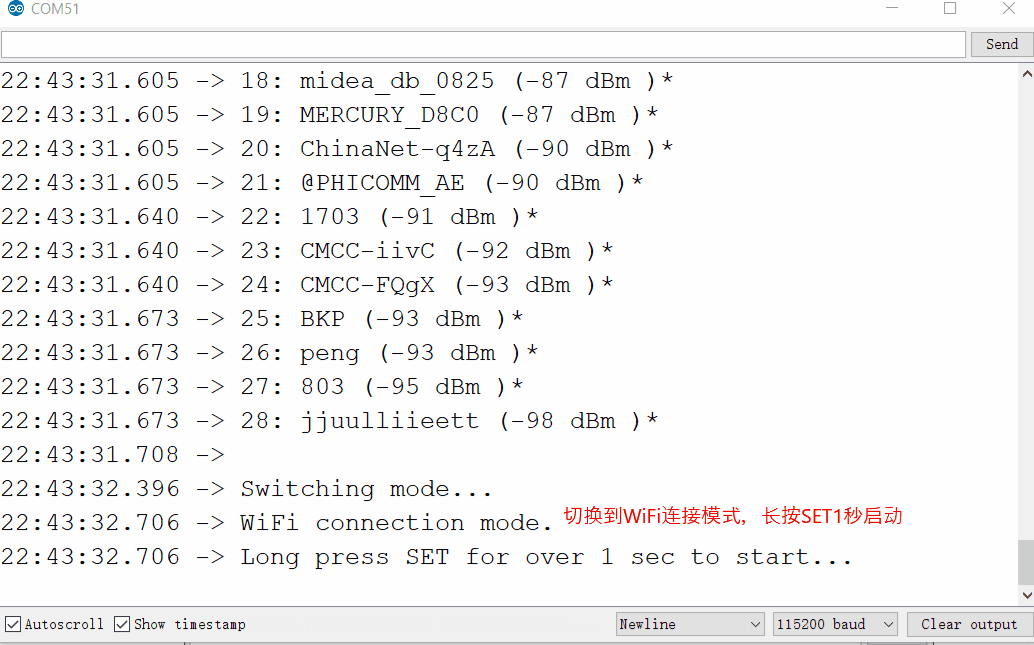 输入SSID和密码登录wifi,注意大小写。连接成功后会显示IP地址、时间、时区。 6.蓝牙BLE透传:RGB指示灯蓝色。 手机上运行nRF Connect,扫描蓝牙,在发现的设备中找到TinkerNode NB-IoT(0xXXXX),其中XXXX为随机的十六进制数,我这里是0XAA55。 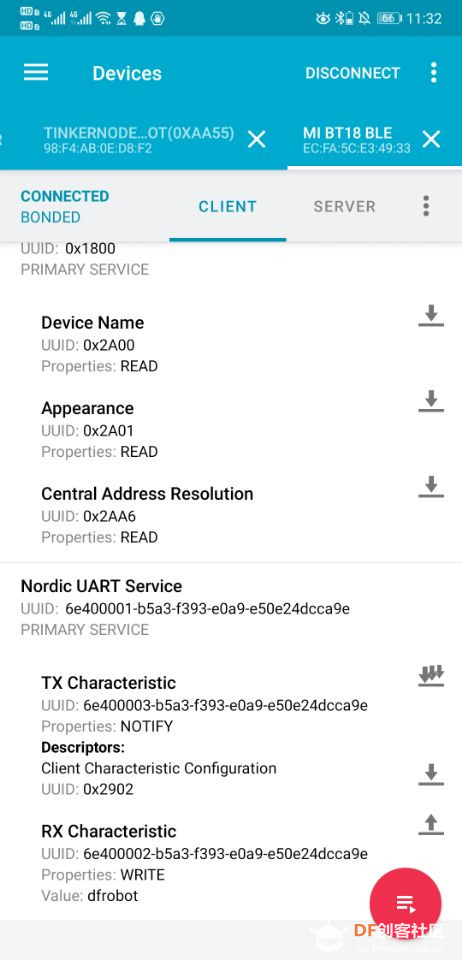 发送0,关闭板载LED灯,发送1,点亮板载LED灯。 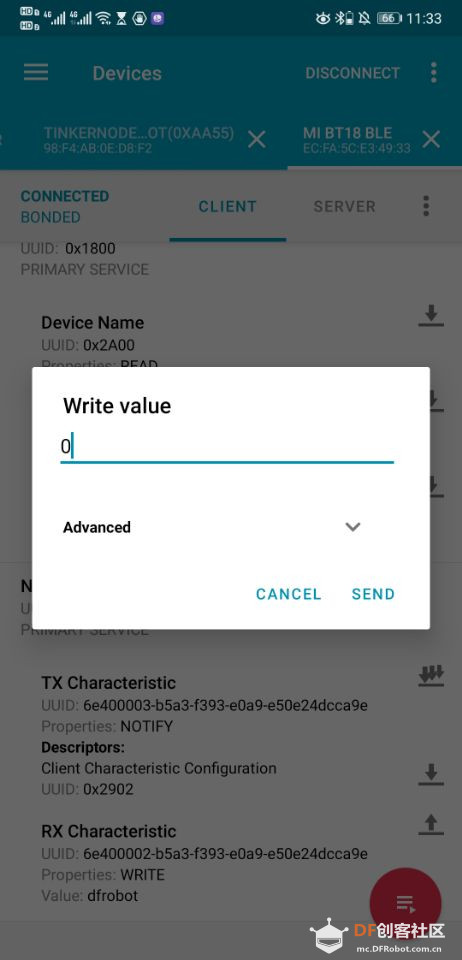 串口监视器接收到相应内容;  如果在串口监视器发送信息,手机上会接受到相应信息。 下面为演示视频: 7.GNSS定位:RGB指示灯青色。 下面的动图可以看到模式刚启动时各参数都显示不出来,随着信号的稳定,参数慢慢出现。 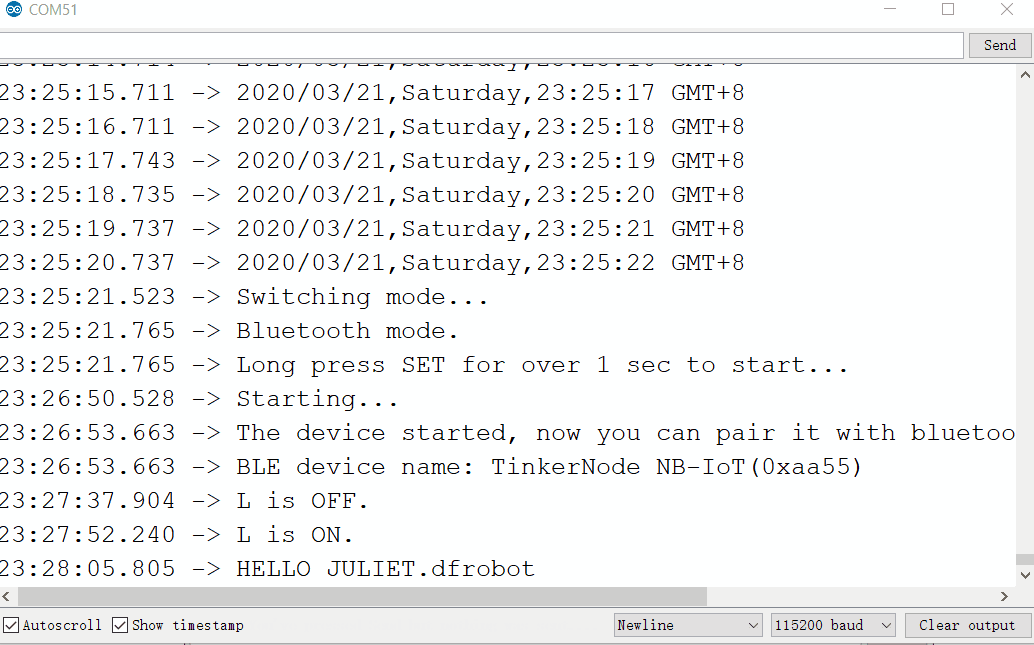 |
 沪公网安备31011502402448
沪公网安备31011502402448© 2013-2026 Comsenz Inc. Powered by Discuz! X3.4 Licensed